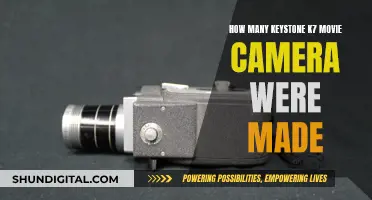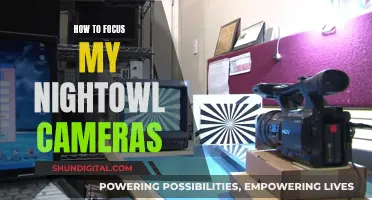
Focusing is a fundamental aspect of photography that can make the difference between a blurry and a sharp image. The focus of a camera can be adjusted manually or automatically, with the latter being a more recent invention. When taking a photo, light is directed through the camera lens, which focuses the light through a combination of its elements. The focus can be adjusted by moving these elements within the lens.
| Characteristics | Values |
|---|---|
| Determining factor | Sharpness of the image |
| Manual focus | Adjusting the focus ring of the camera |
| Autofocus | Mechanism that automatically moves the elements within the lens to achieve the best focus |
| Autofocus area modes | AF-S, AF-C, manual focus |
| Phase detection | Fast, good for tracking moving objects, error-prone |
| Contrast detection | Accurate, slower, good for product or landscape photography |
| Single shot/Single-servo focus mode | Only one focus point is used to determine focus |
| Continuous focusing/Continuous-servo | Camera continuously monitors the distance of the subject and readjusts |
| Automatic autofocus mode | Cross between single shot and continuous focusing |
| Back-button focus | Separates the focus and capture operations |
| Focus stacking | Capturing multiple exposures with different focus points and merging them together |
What You'll Learn

Manual focus vs autofocus
Overview
Photographers have the option to use either manual focus or autofocus to capture sharp images. Autofocus is when the camera sets the point of focus, while manual focus is when the photographer does this themselves. Both methods aim to achieve a clear image of the subject.
Autofocus
Autofocus is the default setting for most modern DSLR cameras. It is generally faster than manual focus, although the speed depends on the camera and lens type. Sports-oriented equipment, for example, tends to be much faster. Autofocus has advanced features such as tracking, which locks the focus on a subject and follows it through the frame. This is particularly useful for capturing moving subjects.
Autofocus relies on contrast to identify objects, so it struggles in low-contrast scenes, such as when there is heavy backlight. It also performs poorly in low-light conditions, as it needs light to determine where to focus. Autofocus can also be confused by scenes with many objects, as it tends to focus on foreground objects.
Manual Focus
Manual focus gives the photographer greater creative control, as they can determine the focus point. It is ideal for situations where autofocus may struggle, such as in low-light conditions or when shooting through glass or fences. Manual focus is also more precise, allowing photographers to carefully select their point of focus from a chaotic scene.
However, manual focus is generally slower than autofocus, making it less suitable for capturing moving objects. It is also not ideal when the photographer cannot see to focus manually, such as when shooting from the hip.
When to Use Autofocus
Autofocus is recommended for most situations, especially when capturing moving subjects, such as wildlife, street photography, or pets.
When to Use Manual Focus
Manual focus is best used in specific scenarios where autofocus struggles. This includes macro photography, deep landscape photography, complex focus bracketing, scenes with many objects or foreground distractions, and low-light conditions such as astrophotography. Manual focus is also useful when you need to nail a precise point of focus, such as a portrait's eye.
The Highest-Resolution Cameras: Pushing Pixel Boundaries
You may want to see also

Autofocus area modes
Single-Point AF-Area Mode
Single-point AF-area mode allows the photographer to select a single focus point for static elements within the scene. The camera will then automatically adjust the focus to ensure the selected point remains sharp. More advanced camera models offer a greater number of focus points, allowing for more precise selection. The central focus points are generally the fastest and most reliable, making them ideal for situations where focus accuracy is critical. Single-point AF-area mode is well-suited to landscape photography and portraits, where the exact focus point is crucial.
Dynamic AF-Area Mode
Dynamic AF-area mode enables the photographer to manually select an initial focus point. If the subject subsequently moves, the camera will utilise the selected point and the surrounding points to maintain focus. The number of surrounding points used depends on the camera model and can typically be adjusted in the settings. This mode is ideal for wildlife and sports photography, where subjects are often in motion.
Group AF-Area Mode
Group AF-area mode is similar to dynamic AF-area mode but allows for the selection of a specific autofocus area with multiple autofocus points. This mode is well-suited to situations where a single AF point is insufficient, but the photographer still wants to focus on a particular subject or zone. Examples include wildlife and sports photography, where there are multiple subjects in a defined area.
Auto AF-Area Mode
Auto AF-area mode is a fully automatic mode where the camera decides which focus points to use based on various factors, including subject distance, motion, and the presence of detectable eyes. This mode is useful for novice photographers or situations where the photographer needs to focus on something close to the camera quickly. However, it may not be ideal when more precise control over the focus point is required.
Camera Batteries: Carry-on Essentials for Air Travel
You may want to see also

Phase detection vs contrast detection
When taking a photo, light is directed through the lens before reaching the recording medium. The lens, whether built-in or interchangeable, is made up of elements that work together to focus the light. This can be done automatically or manually.
Manual Focus vs Autofocus
Manual focus is when the photographer manually sets the focus by adjusting the focus ring of the camera. Autofocus, on the other hand, refers to the mechanism that automatically moves the elements within the lens to achieve the best focus. This is done through a series of autofocus points that are visible through the viewfinder. The camera or the photographer can select a particular focus point to achieve focus.
Phase detection and contrast detection are two different autofocus technologies that work differently.
Phase detection is the system most commonly found in DSLR cameras. It is very fast and, therefore, great for tracking moving objects. The autofocus technology uses two sensors located on each side of the camera lens to detect the phase difference of the light that enters the lens. This allows the camera to determine if the subject is in focus and adjust the lens accordingly. While phase detection is very fast, it may not always get it right.
Contrast detection, on the other hand, is commonly used in mirrorless cameras, point-and-shoot cameras, DSLRs in live view mode, and smartphone cameras. It is much simpler and more accurate than phase detection, which makes it far better suited to genres like product or landscape photography. However, it is also slower. Contrast detection uses the camera's sensor to detect the contrast between light and dark areas in the scene. The camera's processor then analyses the information from the image sensor and aligns the lens to bring the subject into focus.
While there are pros and cons to both systems, there is no clear winner when it comes to choosing between the two. The best autofocus system depends on your personal preference, the type of photography you enjoy, the camera you use, and your budget.
Camera Ticket Dispute: Proving Your Innocence
You may want to see also

Continuous vs single-servo autofocus
When it comes to autofocus, there are a number of different modes to choose from, each of which is better suited to a particular scenario. Here, we will focus on two of these autofocus modes: single-shot/single-servo autofocus and continuous autofocus.
Single-Shot/Single-Servo Autofocus
In single-shot or single-servo autofocus mode, only one focus point is used to determine the focus, and this does not change until you refocus manually. This means that when you press or half-press the shutter button, the camera will focus on the subject once and lock that focus until you take your finger off the shutter release button or refocus manually. This is shown as ‘One-Shot’ on Canon and ‘AF-S’ on Nikon cameras.
Continuous Autofocus
Continuous autofocus, on the other hand, is designed for shooting moving subjects. Once a focus point is set, the camera will continuously try to monitor the distance of the subject from the camera and readjust as necessary for as long as the focus button is held down. This is shown as ‘AI Servo AF’ on Canon, ‘AF-C’ on Nikon, and ‘AF-C’ on Sony cameras.
Different camera manufacturers indicate in different ways when the focus is achieved in continuous autofocus mode. For example, the autofocus point on Canon cameras will turn blue once the subject is in focus. So it is important to know your camera to avoid ending up with a blurry image.
When to Use Single-Shot/Single-Servo vs Continuous Autofocus
Single-shot/single-servo autofocus is best suited for shooting subjects that are not in motion, whereas continuous autofocus is ideal for capturing moving subjects. Single-shot/single-servo autofocus allows you to keep the focus locked even if you recompose the shot and move the camera, as long as you keep your finger on the shutter button. Continuous autofocus, on the other hand, will continuously adjust the focus to keep the subject sharp, even if the subject or the photographer are moving.
Mastering Landscape Photography: Focus Techniques for Stunning Shots
You may want to see also

When to use manual focus vs autofocus
Manual focus and autofocus are two different ways of achieving the same goal: a clear shot. Autofocus allows the camera to set the focal point, while manual focus gives the photographer more creative control by letting them set the focal point themselves.
When to use autofocus
Autofocus is generally faster than manual focus, making it ideal for action photography, such as sports or wildlife photography. It is also useful when you are photographing moving subjects, like birds in flight or running athletes. Autofocus has advanced features like tracking, which allow the camera to lock focus on a subject and follow it through the frame.
Autofocus is also useful when you are shooting in low-light conditions, as it can be challenging to focus manually in such situations. Additionally, autofocus is a good choice when you have a fast-moving scene and know where your subject will be in advance. For example, if you are photographing a bird that keeps flying to the same perch, autofocus can quickly lock focus on the perch as soon as the bird arrives.
When to use manual focus
Manual focus is ideal when autofocus struggles, such as in low-light or low-contrast situations. It is also useful when you are shooting through glass or fences, as autofocus can get confused by the foreground objects.
Manual focus is also recommended for macro photography, as it allows for precise focusing at high magnifications. It is also useful for landscape photography, especially when you need to nail the hyperfocal distance.
If you are doing complex focus bracketing or taking a series of images where you don't want the focus to change, manual focus is the way to go. It gives you the flexibility to choose the object you want to focus on, even in scenes with many objects.
In conclusion, the choice between autofocus and manual focus depends on the photographer's needs and shooting conditions. While autofocus is generally faster and more convenient, manual focus offers greater precision and control in certain situations.
Candid Camera Mode: Periscope's Secret Weapon
You may want to see also
Frequently asked questions
Manual focus is when the photographer manually adjusts the focus ring of the camera. Autofocus, on the other hand, is when the camera system automatically moves the elements within the lens to achieve the best focus.
Autofocus uses a motor in the camera or lens to focus on a subject you've selected. The camera can either focus on a subject you've chosen manually, or it can select a subject for you.
The two main types of autofocus systems are phase detection and contrast detection. Phase detection is faster and better for tracking moving objects, while contrast detection is more precise and accurate, making it better suited for genres like product or landscape photography.
The two most common autofocus modes are continuous-servo and single-servo. Continuous-servo is ideal for photographing moving subjects, as the camera continuously adjusts focus while you hold down the focusing button. Single-servo, on the other hand, locks the focus once it has been acquired and doesn't readjust until you release the button.
You can check if an image is in focus by its sharpness. The sharper it looks, the more in focus it is. However, keep in mind that sometimes photographers intentionally use blur to highlight or hide certain parts of an image for artistic effect.







